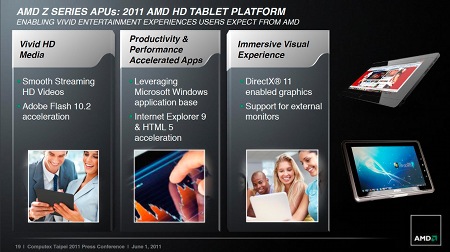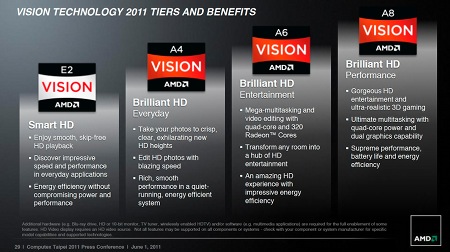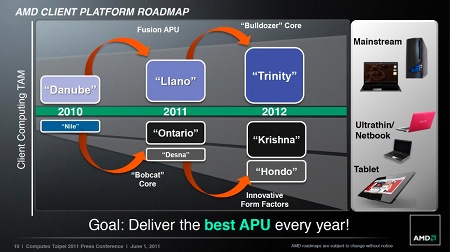AMD processors take on tablets
Jun 1, 2011 — by LinuxDevices Staff — from the LinuxDevices Archive — 3 viewsAs expected, AMD used a morning press conference in Taipei to announce its tablet-specific Z-Series processors — the first of which is the dual-core Z-01, with a 5.9-Watt TDP. The chipmaker also reviewed branding plans for its A-Series “Llano” processor for notebooks, shipping this month, and previewed downsized APUs (accelerated processing units) it plans to release later this year.
AMD appears to be striving to provide just as confusing an array of processors as its rival Intel, so we're compelled to begin with some background. The company's APUs for the mobile and embedded space use x86 microarchitectures known as "Bobcat" and "Bulldozer." (Its higher-end desktop and server CPUs use Bulldozer too; we'll touch on that later.)
AMD's first "Fusion" APUs were announced in January, with single- or dual- Bobcat cores on board. These initial E-Series and C-Series products — already successful in a variety of mini-notebooks — were followed up by a passel of G-Series versions for embedded devices. All of the Fusion devices integrate CPUs with "discrete-level" GPUs on one chip.
Worth noting: The E-Series, C-Series, and G-Series are all manufactured for AMD by TSMC (Taiwan Semiconductor Manufacturing Company) using a 40nm process. Meanwhile, AMD's Bulldozer-based A-Series "Llano" processors are produced for it by Globalfoundries on 32nm wafers.
At its June 1 Computex press conference, AMD gave short shrift to Llano. (We'll return to the A-Series later in this story, however, since these APUs will play a key role in mainstream desktops and laptops.) This may be because the company's still reeling from initial 32nm production problems, eventually resolved last April, but it also served to emphasize the company's belated conversion to the tablet religion.
AMD's new Z-Series
AMD played up tablets by announcing its Z-Series processors, intended specifically for tablet devices. These previously rumored "Desna" parts are closely related to the E-Series, C-Series, and G-Series, with the same Bobcat cores and 45nm process.
According to AMD, the initial Z-Series processor — which is already shipping — is the Z-01, with the following features:
- 1.0GHz clock speed
- two Bobcat cores
- Radeon HD6250 graphics, with 80 GPU cores
- 5.9-Watt TDP
Apart from a more favorable TDP, these specifications are the same as AMD's earlier C-50, which has already featured in one tablet, Acer's Iconia Tab W500. The company provided no details of what it has done to lower power consumption, leading us to suspect that it's testing chips as they come off the line and simply relabeling those that pass muster at low voltages. (We similarly wonder the same about last month's G-Series T40E and T40R, which were announced last month with 6.4- and 5.5-Watt TDPs but seemed otherwise-identical to the earlier, 9-Watt T44R and T40N.)

AMD's Z-Series processors will be Windows-friendly
(Click to enlarge)
In contrast to Intel — which has emphasized its tablet processors' ability to boot into Windows, Android, or MeeGo — AMD seems to be tying its fortunes more to Microsoft. The company's presentation (above) stressed the Z-01's DirectX graphics, Internet Explorer 9 acceleration, and compatibility with Adobe Flash 10.2.
However, AMD brought Rosen Sharma, CEO of BlueStacks, on stage to demonstrate software that will permit launching Android apps directly from the Windows desktop. As we reported last month, BlueStacks offers a "lightweight, optimized, soft hypervisor" that will initially focus on x86 Windows hosts (versions using Android and Chrome OS hosts to run Windows apps are also being mooted).
Tim Bajarin, President of Creative Strategies, was quoted as saying "BlueStacks acknowledges consumers' lifestyles by delivering a single UI and apps environment that can be used on every one of their digital screens. If an x86 Windows machine can run Android seamlessly and be integrated into the Windows experience well, it gives new life to x86-based devices like those from AMD."
More about the A-Series
As we've noted, AMD's June 1 press conference at Computex featured relatively few details about the company's A-Series processor. Rick Bergman, senior vice president and general manager of the company's products group, was quoted by ZDNet as saying, "We're done with Llano now. We're busy working on the next greatest thing."

AMD's A-Series processors
(Click to enlarge)
Executives did confirm, however, that the Llano processors will be branded the A-Series, and available in A4, A6, and A8 versions, as shown above. Several weeks ago, the Donamin Haber website leaked the table below, whose information about specs and pricing has been widely repeated or confirmed elsewhere. (The "Zambezi" parts indicated are for desktop devices employing traditional discrete graphics cards.)

More details on AMD's A-Series
Source: Donamin Haber
(Click to enlarge)
AMD also showed off Trinity (below), a successor to Llano that uses a next-generation Bulldozer core and which, they suggested, will be released later this year. Meanwhile, the "Ontario" and "Desna" cores will be replaced around the same time by "Krishna" and "Hondo" cores, the company further indicated.

AMD's Bulldozer- and Bobcat-based processors are set for an upgrade
(Click to enlarge)
It appears few details were offered on either Krishna or Hondo, but reports say these will represent a move from 45nm to 28nm production, allowing for further power savings. Meanwhile, officials claimed notebooks using its 1.6GHz E-350 processor can, with a six-cell battery, already achieve more than ten hours of battery life when idle, or more than four hours' life when 3D graphics are active.
Further information
Though performance desktops are outside our bailiwick, AMD also announced its 9-series chipset, which it said will be built into boards featuring its backwards-compatible AMD3+ processor sockets. These will be included in a next-generation "Scorpius" desktop platform, which will also feature an eight-core "Zambezi" processor and AMD Radeon HD6000 discrete graphics cards, for "extreme multitasking, tweaking, and overclocking," the company added.
The AMD Computex presentation from which slides in this story were extracted may be downloaded in PDF format from the company's website.
Jonathan Angel can be reached at [email protected] and followed at www.twitter.com/gadgetsense.
This article was originally published on LinuxDevices.com and has been donated to the open source community by QuinStreet Inc. Please visit LinuxToday.com for up-to-date news and articles about Linux and open source.